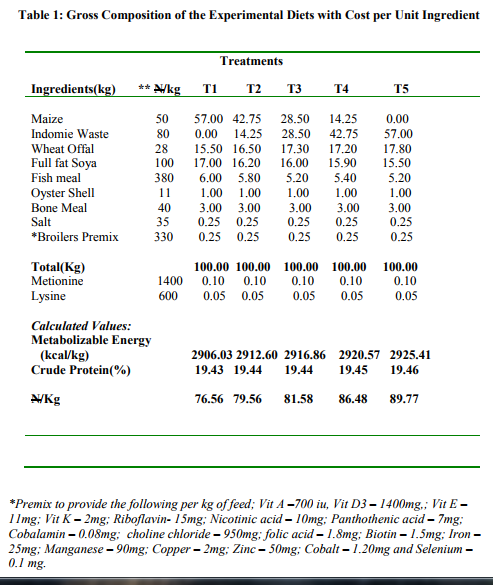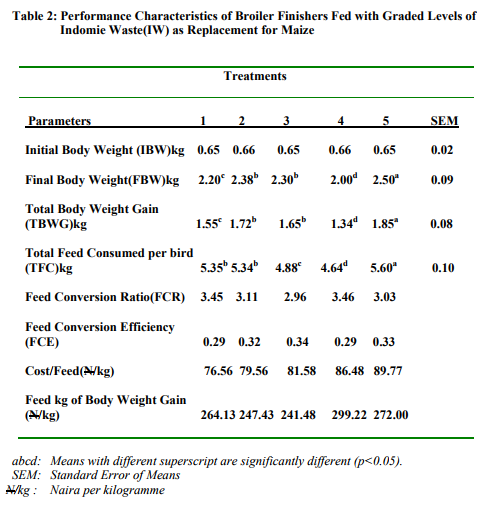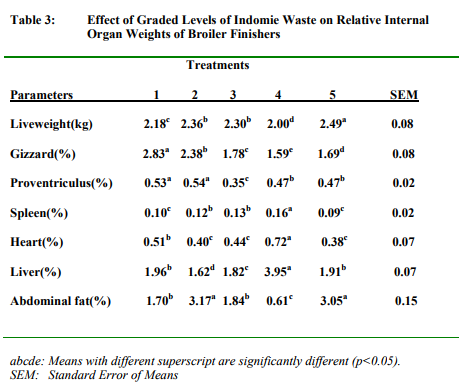IJCRR - 2(8), August, 2010
Pages: 45-53
Print Article
Download XML Download PDF
GROWTH RESPONSE OF BROILER FINISHERS FED DIET WITH GRADED OF INDOMIE NOODLE WASTE MEAL AS REPLACEMENT FOR MAIZE
Author: Alabi, O. M. Ayoola, M.O
Category: General Sciences
Abstract:The replacement value of Indomie Waste (IW) in Maize-based Broiler finisher diets was investigated. One hundred and fifty (150) unsexed Hypecco strain of Broilers were randomly allotted into five isocaloric and isonitogenous dietary groups with graded levels of Indomie Waste in weight for weight replacement for maize.
Treatment 1(T1) contained 100% maize,T2(25%maize,75% IW),T3(50% maize,50% IW),T4(25% maize,75% IW) and T5(100% IW). The experiment lasted for five weeks(5 to 10 weeks of age) during which data was collected in respect of weekly body weight, daily feed intake while Feed Conversion Ratio(FCR), Feed
Conversion Efficiency(FCE) and cost of feed per kilogram body weight gained were calculated. Also, some internal organs were weighed in all the dietary group samples at the end of the experiment. Data analysis revealed that replacement of maize with IW in Broiler Finisher diets had significant (p< 0.05) effect on Total Feed Intake ,Final Body, Total Body Weight Gain, FCR,FCE and Cost per Feed per Body Weight gained of the birds and also on the relative weight of the internal organs investigated. Meanwhile, birds on T3 gave the best result in term of feed conversion and cost effectiveness. Maize can be replaced with Indomie Waste at 50% weight for weight in the diets of Broiler finishers.
Keywords: Broiler finisher, Cost, Graded levels, Growth, Indomie Waste, Maize.
Full Text:
Introduction
There has been a steady increase in the cost of conventional feed ingredients such as maize, groundnut cake, soyabean meal and fish meal in the past years and this has led to increase in the prices of animal protein sources [1] . While it is very easy to place ruminants on natural pastures, monogastrics must be provided with balanced diets with all nutrients both quantitatively and qualitatively. Over the years, the bulk of research works on livestock production has been on ways to reduce the cost of feeding the animals through the utilization of agro-industrial by-products (AIBs) and other materials that seem to be non important to the livestock. Various AIBs have been investigated to be useful for livestock feeding. Brewers Dry Grain (BDG), wheat offal, corn offal, rice bran, cassava sievate, cassava peels to mention few have been widely tested and incorporated into livestock feeding.[2,3,4,5,6] . These ingredients can be incorporated into the diet of monogastrics without any detrimental effect on the performance and health of the animals and thereby reducing the cost of feeding.
However, seasonal variations in the availability of these AIBs have pushed researchers into the investigations of nonconventional feed ingredients with the intention of reducing the cost of production in order to make animal protein affordable to the populate [7]. Such non conventional feed ingredients include the seeds and leaves of some forest trees and forages. The extent to which some of these such as Acacia, albido pods [8] , Luffa cylindrica seeds meal [9]Solanum nigrum L.var, virginum leaves and seeds [10] , Stylosanthes guianensis [11] , Moringa olifera leaf meal [12],fluted pumpkin leaf [13] can be utilized by non-ruminants have been well investigated and documented. Meanwhile, many food factory waste products have been considered as ingredients that can be utilized by monogastrics. Examples are cassava meal, wheat and corn flour dusts, biscuit wastes, sorghum sprout, cocoa pod meal, poultry offal and Indomie noodle waste to mention few [14] . Indomie noodle waste (IW) is derivable from Indomie noodle which is very popular in Nigeria as a fast food for young and adults and is well accepted in the country. Apart from being well balanced with reasonable value of metabolizable energy, digestible protein with good aroma before, during and after cooking, the product is approved by the Nigerian Agency for Food, Drinks Administration and Control (NAFDAC). The major ingredients in Indomie noodle are wheat and palm oil which make it to be energy rich. The objective of this research work is to investigate the replacement values of Indomie waste for maize in broiler finishers diets in terms of growth response of the birds and the cost implications.
Materials and Methods The research was conducted at the Broilers section of the poultry unit of the Teaching and Research farm of Bowen University, Iwo, Nigeria. Two hundred (200) unsexed broilers of Hypecco strain were purchased at day old from a reputable hatchery in Ibadan, Nigeria. They were brooded for three weeks during which feed (commercial broiler starter mash) and water were provided ad libitum and other management practices in terms of medication and vaccination were strictly observed. Five isocaloric and isonitrogenous experimental diets were formulated at graded levels of maize and IW replacement on weight for weight basis At the end of the third week, 150 birds were weighed and randomly allotted to the five dietary groups with thirty chicks each. The groups were subdivided each into three replicates of ten birds each in a Completely Randomized Design (CRD). The dietary groups are: T1 (control with 100% maize with no IW); T2 (75% maize and 25% IW); T3 (50% maize and 50% IW); T4 (25% maize and 75% IW) and T5 (100%IW and no maize). The birds were allowed to adjust for one week while (4th week). Data collection started at the beginning of 5th week of age and lasted for five weeks. Parameters investigated were daily feed intake, weekly body weight while feed conversion ratio(FCR), feed conversion efficiency(FCE),unit cost of each diet, cost per weight gain were calculated.
Moreover, at the end of the 9th week, six birds were randomly selected per dietary group and were weighed, humanely bled, defeathered, eviscerated and the weight of some internal organs such as the gizzard ,proventriculus ,spleen heart, liver and abdominal fat were measured and expressed relatively as the percentage of the liveweight.
Statistical Analysis
Data generated were subjected to a oneway analysis of variance (ANOVA) using the Statistical Analysis Software [15] and significantly different means were separated with the Duncan?s option of the same software at 5% level.
Results
Table 1 shows the Gross Composition of the experimental diets with their respective cost as at the time of the research. The diets were isocaloric and isonitrogenous while the price per kilogram of maize was N50 and that of IW was N80. Table 2 shows the Performance Characteristics of the broiler finisher chickens fed with graded level of IW as replacement for maize. Parameters investigated on average basis were Initial Body Weight(IBW),Final Body Weight(FBW),Total Body Weight Gain(TBWG),Total Feed Consumed (TFC) per bird while Feed Conversion Ratio (FCR),Feed Conversion Efficiency(FCE) and Feed Cost Per Kilogram Weight Gained (CPW) were calculated.
No significant (p>0.05) difference was observed between the mean IBW of the broiler chicken. The value ranged from 0.65kg to 0.66kg. Other parameters were however influenced by the dietary treatments.
Birds on T5 (100%IW) had the highest average FBW of 2.50kg significantly (p0.05) difference was observed between the mean FBW of birds on T2 and T3 but they differed significantly (p0.05) difference was observed between the mean values for TFC of birds on T1, T2 but they differed significantly (p<0.05) from T3, T4 and T5 which in turn differed from each other significantly (p<0.05). The range was from 4.64kg (T4) to 5.60kg (T5). Meanwhile, birds on control group(T1) had the highest FCR of 3.45 while the least and the best (2.96) was from birds on T3 and invariably, birds on T3 had the highest efficiency of feed utilization of 0.34 (34.00%) otherwise known as the Feed Conversion Efficiency. The cost analysis as at the time of the research revealed that the more the inclusion of the Indomie Waste in the broilers diet, the higher the price per kilogram of the feed. Moreover, for every kilogram of weight gained, it cost birds on T1 N264.13, T2; N247.43, T3; N241.48, T4; N299.22 and T5; N272.00. Table 3 shows the effect of graded level of IW on the internal organ weights of the broiler chickens at finisher phase. Internal organs weighed were gizzard, proventriculus, spleen, heart, liver and abdominal fat and the values were relatively expressed as the percentage of the liveweight.
The dietary treatments had significant effect on the relative internal organ weights of the broiler chickens at finisher phase. The mean % gizzard ranged from 1.59(T4) to 2.83(T1).For the % proventriculus, no significant(p>0.05) difference was observed between the values for birds on T1 and T2 ,T4 and T5 but these pairs differed from each other and from T3 significantly(p<0.05). The value ranged from 0.35 %( T3) to 0.54%(T2). Other internal organ weights were significantly (p<0.05) affected by the dietary treatments in various trend.
Discussion
Indomie Waste contains higher metabolizable energy than maize as reported by [16] and this may be responsible for the lower feed intake by birds on diets containing Indomie Waste compared to the control group with maize only except for T5 where TFC was ironically the highest. The energy content of IW may also be responsible for the better FBW and TBWG of birds on T2 to T5. The palatability of IW may however be responsible for the very high TFC by birds on T5. Moreover, the values of FCR and FCE revealed that birds on T3 gave the best results in terms of the feed utilization and it is the most cost effective dietary group and these are the profitability indicators in Broiler production. The poor performance of birds onT4 could not be linked to any measurable factor. However, the birds in the group may be incubating one disease factor or the other and this may be responsible for the poor growth and body weight although no mortality was recorded during the experiment to confirm this claim. This suspicion is however corroborated by the higher liver weight of the birds in this dietary group. This hepatohypertrophy may be due to latent infection although no pathological test was carried out to confirm this. Furthermore, higher abdominal fat content of the birds on IW based diet may be linked to higher fat and oil content of the IW than that of maize. Indomie waste meal can be used to replace maize in the diet of broiler finishers with the best performance at 50% weight for weight replacement. The replacement will be more effective whenever the price of maize per kilogram is higher than that of Indomie waste.



References:
1. Adejinmi.O.O,Hamzat,R.A,Fapohunda, J.B. Performance and Nutrient digestibility Rabbits fed fermented and unfermented cocoa pod..Nig.Jour.for Anim.Prod 2007;34(1): 63-68.
2. Farinu,G.O.Effect of feeding a Compound Diet Based on NonConventional Feedstuffs on Growth and Carcass Characteristics of Rabbits. World Rabbit Science 1994;2(4):123- 126.
3. Ajayi, F.O.,Balogun, O.O., Ovuru, S.S. and Mgbere,O.O.(2005). Reproductive Performance of Rabbits fed MaizeMilling Waste Based Diets. African Journal of Biotechnology 2005;Vol.4(5):439-443.
4. Aderemi,F.A.,Alabi,O.M.and Lawal, T.E. (2006). Utilization of Whole cassava meal by Egg-type Chicken. In Raji AM,Oluokun JA, Odukoya SO.editors ASAN 06.Proceedings of the 11th Conference on Animal Science.2006.Sep 18-21.IARand T, Ibadan,Nigeria.p. 73-75.
5. Afolabi,K.D., Iyayi, E.A., Abu, O.A., Fakolade,P.O.and Adebiyi,O.A.Effects of solid Substrate fermentation by Aspergillus niger and Rhizopus spp.on the nutritional value Of cassava peel. In Raji AM, Oluokun JA, Odukoya SO.editors ASAN 06.Proceedings of the 11th Conference on Animal Science.2006.Sep 18- 21.IARand T,Ibadan,Nigeria.p.169-172.
6. Omole, A.J, Adejuyigbe, A,Ajayi, F.T, Fapohunda, J.B. Nutritive Value of Stylosanthes guianensis and Lablab purpureus as sole feed for Growing Rabbits. African Journal of Biotechnology 2007; Vol. 6 (18), pp.2171-2173
. 7. Olabanji, R.O., Ojebiyi, O.O., Tona, G,O.and Olaogun,O. Haematological and Serum Biochemical Response of Growing Rabbits fed Diets Containing Mango(Mangifera indica) Seed Kernel Meal. In Akinlade JA,Olayemi TB,Rafiu TA,Odunsi AA.editors ASAN 09. Proceedings of the 14th Conference on Animal Science, 2009. Sep 14-17. LAUTECH, Ogbomoso,Nigeria. p.270- 273.
8. Igwebuike, J.U., Anugwa, F.O.I., Raji, A.O., Ehiobu, N.G.and Ikurior, S.A. Nutrient Digestibility, Haematological and Serum Biochemical Indicies of Rabbits fed Graded Levels of Acacia albida Pods. ARPN Journal of Agricultural and Biological Sciences 2008;Vol.3,No.4:33-40.
9. Dairo, A. Performance and Haematological Evaluation of Weaner Rabbits Fed Loofah Gourd Seed Meal(Luffa cylindrical{M.J.ROEM}) . African Journal of Food,Agriculture Nutrition and Development 2008;8(4):451-463.
10. Akubugwo,I.E.,Obasi,A.N.and Ginika, S.C. Nutritional Potential of the Leaves and Seeds Of Black Nightshade-Solanum nigrum L.Var virginicum from Afikpo-Nigeria. Pakistan Journal of Nutrition 2007;6(4):323-326.
11. Omole, A.J., Adejuyigbe, A.,Ajayi, F.T. and Fapohunda,J.B. Nutritive Value of Stylosanthes guianensis and Lablab purpureus as sole feed for Growing Rabbits. African Journal of Biotechnology 2007; Vol.6 (18), pp.2171-2173.
12. Okeke, E.N., Usman, J.M., Osalusi, C.S., Akinola, O.O., Abiola, J.K. and Nwachi, A.C.Performance Characteristics and Haematological Profile of Adult Rabbits fed Morringa Oliefera Leaf Meal Supplements. In Akinlade JA,Olayemi TB, Rafiu TA, Odunsi AA.editors ASAN 09. Proceedings of the 14th Conference on Animal Science, 2009. Sep 14- 17.LAUTECH,Ogbomoso,Nigeria. p.400-401.
13. Alabi.O.M., F.A.Aderemi., M.O. Ayoola, T.E. Lawal., A.A.A dewumi, A.O.Oguntunji,et al. Performance characteristics and gut Morphology of broiler chickens fed with oral supplementation of Telfaria occidentalis Leaf extract at finisher phase. In Akinlade JA,Olayemi TB,Rafiu TA,Odunsi AA.editors ASAN 09. Proceedings of the 14th Conference on Animal Science, 2009. Sep 14-17.LAUTECH, Ogbomoso, Nigeria. p. 354-356.
14. Eniolorunda, O.O., Taiwo, B.B.A., Oyewumi, O.O. and Adeyemi, O.A. Performance of Laying Hens Fed Graded Levels of Indomie Waste as Replacement for Maize in a Humid Tropical Environment. Research Journal of Animal Sciences 2008; 2(5):135-138.
15. SAS Statistical Analysis Systems. Institution Users Guide, SAS Institute, Cary, N.S;1999.
|






 This work is licensed under a Creative Commons Attribution-NonCommercial 4.0 International License
This work is licensed under a Creative Commons Attribution-NonCommercial 4.0 International License